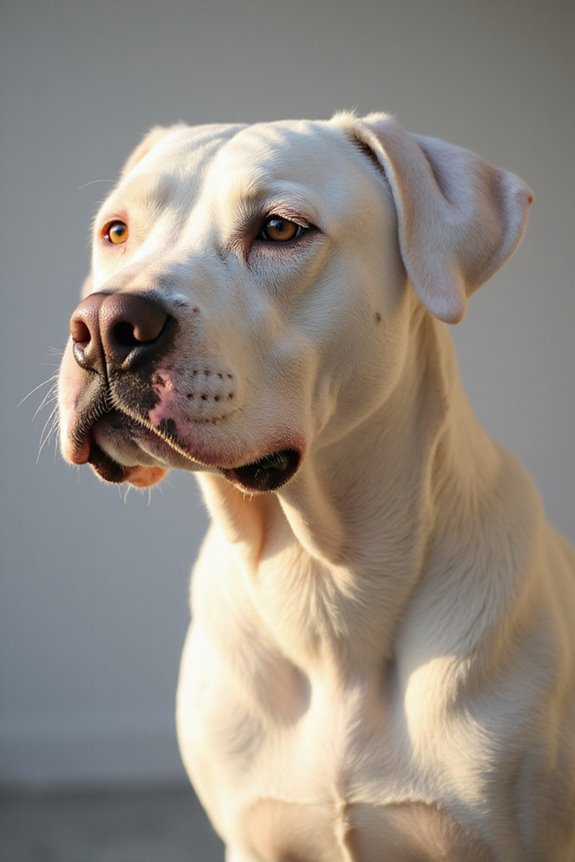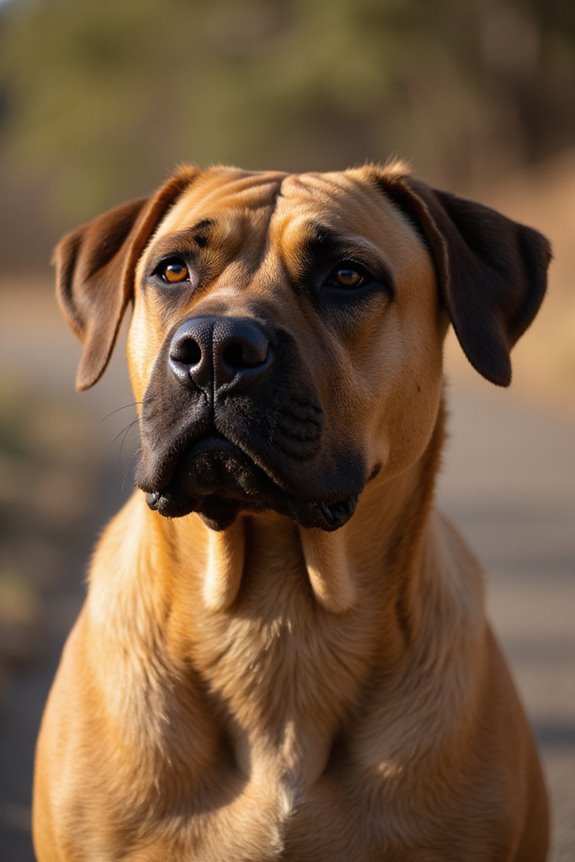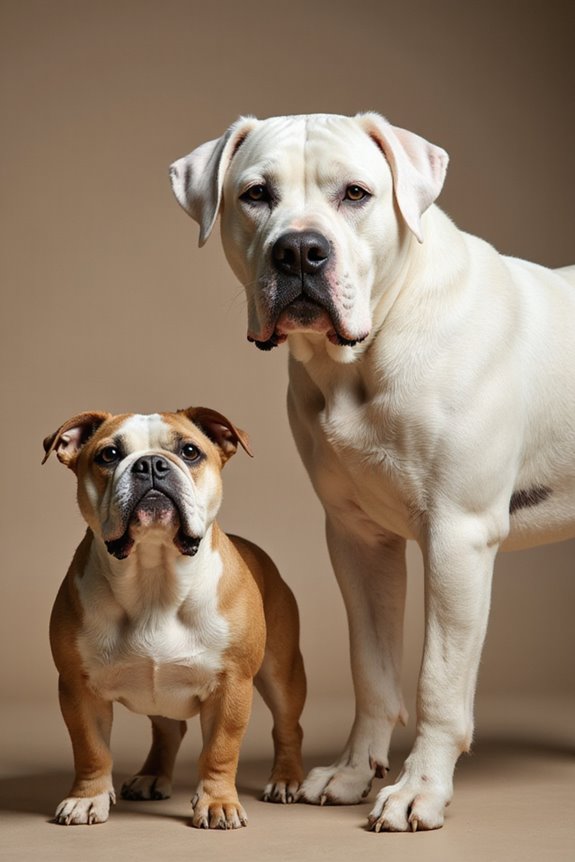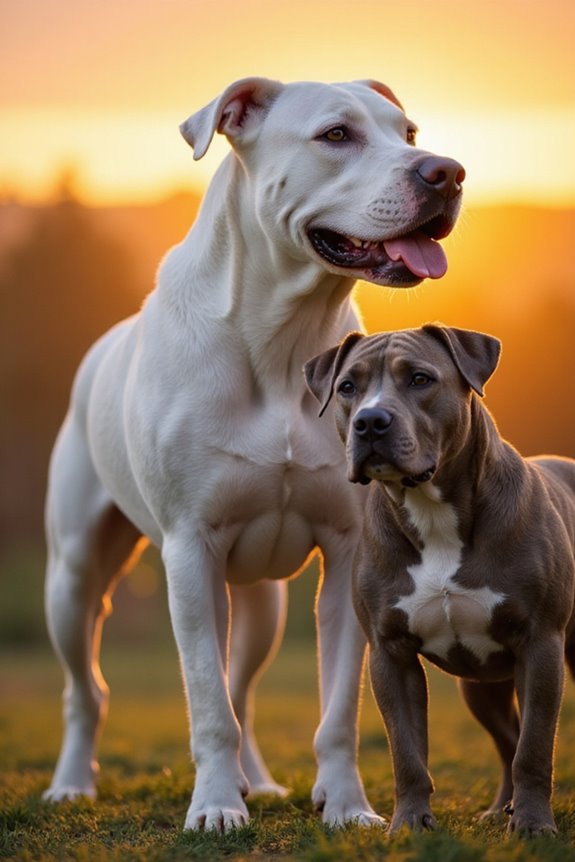When comparing the Dogo Argentino and Pitbull regarding fighting, several factors come into play. The Dogo Argentino features a stronger bite force of around 500 PSI, compared to the Pitbull’s 235 PSI, reflecting its purpose in hunting large game. Additionally, the Dogo’s size and musculature provide an advantage in endurance, while the Pitbull excels in agility and explosive strength. Understanding their distinct characteristics can give insights into their potential performance in a confrontation; further exploration reveals more nuanced factors influencing their capabilities.
Key Takeaways
- Dogo Argentinos have a significantly stronger bite force at 500 PSI, compared to Pitbulls at 235 PSI, giving them an advantage in a confrontation.
- The larger size and musculature of Dogo Argentinos provide them with strength and endurance, making them formidable opponents in fights.
- While Dogo Argentinos excel in endurance, Pitbulls outperform in quick, explosive strength suitable for short, intense bouts.
- Temperament differences may affect fight outcomes: Dogo Argentinos’ protective nature contrasts with Pitbulls’ playful and outgoing demeanor.
- Both breeds require careful consideration of training and socialization, as their behaviors can influence their performance in fighting scenarios.
Physical Size and Musculature Comparison
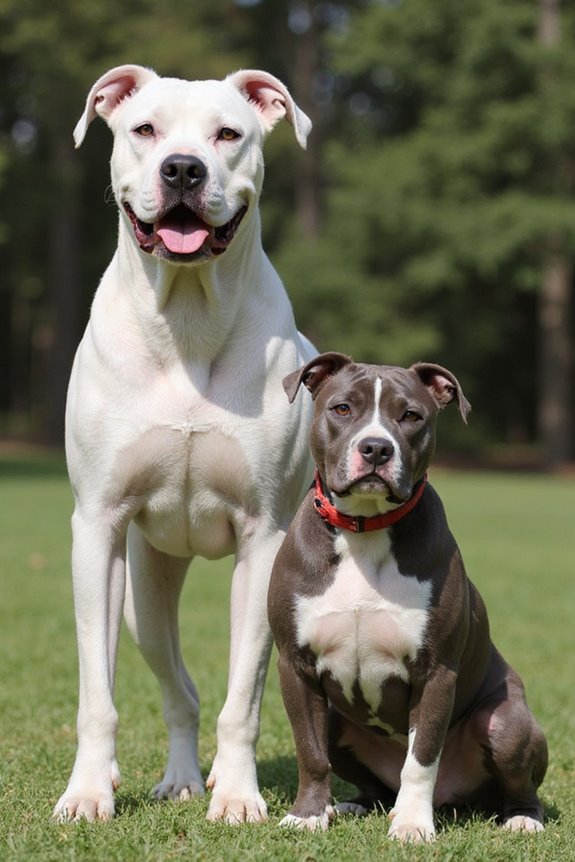
When comparing the physical size and musculature of the Dogo Argentino and the Pitbull, it’s essential to recognize the significant differences between the two breeds.
- Size Implications: Dogo Argentinos typically weigh between 80-100 pounds, while Pitbulls range from 25-80 pounds. This difference makes the Dogo Argentino appear more imposing.
- Build Characteristics: The Dogo has a broad chest and large head, built for strength and endurance. In contrast, Pitbulls are stockier, emphasizing agility and explosive power.
These size implications not only affect their physical presence but also their abilities. Dogo Argentinos excel in endurance tasks like hunting, whereas Pitbulls shine in short bursts of speed and agility. Each breed’s characteristics reflect distinct roles they were bred for, influencing their overall performance.
Bite Force and Jaw Strength Analysis

Analyzing the bite force and jaw strength of the Dogo Argentino and Pitbull reveals not only their physical capabilities but also their intended uses within specific roles. The Dogo Argentino boasts a formidable bite force of approximately 500 PSI, considerably stronger than the Pitbull’s 235 PSI. This remarkable strength is designed for hunting large game, such as wild boars.
In contrast, Pitbulls possess powerful jaws optimized for quick bursts of strength, suitable for dog sports. Their design allows for effective gripping and endurance but lacks the sheer pressure of the Dogo.
Both breeds exhibit unique jaw strength advantages shaped by their intended purposes, with the Dogo Argentino excelling in raw biting power, while the Pitbull thrives on agility and tenacity.
Athleticism, Speed, and Endurance Evaluation
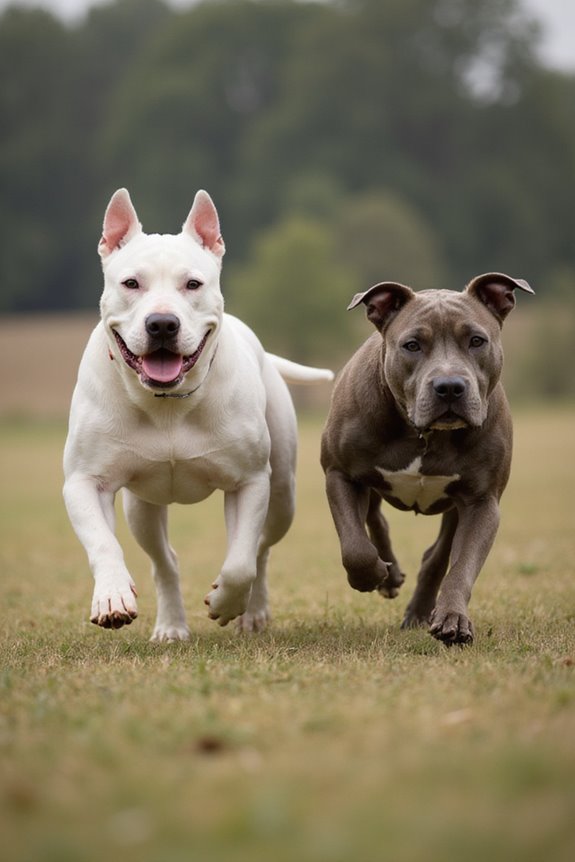
In evaluating the athleticism, speed, and endurance of both the Dogo Argentino and Pitbull, it becomes clear that each breed possesses strengths tailored to their specific roles and purposes.
- Athletic Performance: The Dogo Argentino, bred for big game hunting, showcases incredible endurance, capable of running long distances without tiring. In contrast, the Pitbull excels in explosive power and quick reflexes, evident in their impressive sprinting capabilities.
- Stamina Comparison: While the Pitbull thrives in short bursts of high-intensity activities like agility courses, the Dogo Argentino’s remarkable stamina suits them for prolonged exertions, essential in hunting scenarios.
Ultimately, both breeds require regular exercise to maintain their athletic prowess, demonstrating distinct qualities that impress in their respective environments.
Temperament and Loyalty Traits

Understanding the temperament and loyalty traits of the Dogo Argentino and Pitbull can provide valuable insights for potential owners and enthusiasts.
Both breeds exhibit substantial loyalty and unique behavioral traits, making them excellent family dogs when socialized properly. Here’s a quick breakdown:
- Dogo Argentino: Protective, confident, and serious. Their natural guarding instincts create strong territorial behaviors, which require supervision, especially around children.
- Pitbull: Affectionate, playful, and outgoing. They tend to form strong bonds with families, often displaying a friendly demeanor toward kids and guests.
Both breeds need experienced owners capable of consistent, positive training to foster good family interactions and manage aggression tendencies. Early socialization is essential for promoting harmonious relationships within the family and preventing behavioral issues.
Intelligence and Trainability Insights

One might be surprised to learn how intelligent and trainable both the Dogo Argentino and Pitbull breeds are, despite their differing training approaches.
- Intelligence Levels: Dogo Argentinos rank among the top 10 breeds for intelligence, excelling in tasks requiring mental stimulation. Pitbulls are intelligent too, but may exhibit stubbornness.
- Training Approaches: Both respond best to positive reinforcement. Dogo Argentinos generally learn commands quickly, while Pitbulls need patient guidance.
- Behavioral Responses: Consistent training helps channel a Dogo’s protective instincts, while Pitbulls are responsive to their owners’ emotional states.
- Mental Stimulation: Engaging activities are critical for both breeds to prevent behavioral issues. Regular training sessions with new challenges can maintain focus and foster obedience, making them well-mannered companions.
Use and Historical Roles Overview
The historical roles and uses of the Dogo Argentino and Pitbull reveal a complex tapestry of breed development shaped by human needs and environments. The Dogo Argentino was originally developed in the early 20th century by Antonio Nores Martinez to hunt large game, showcasing notable hunting techniques and impressive stamina. Its breeding history involved various breeds to enhance strength and agility, making it versatile in both hunting and other roles, like police work and therapy. Conversely, Pitbulls emerged from bull-baiting origins in the 19th century, known for their tenacity and loyalty as family companions. While historically associated with fighting, they’ve adapted well to various responsibilities, including search and rescue, proving their resilience beyond just their contentious past.
Frequently Asked Questions
Which Breed Has Better Health and Lifespan Longevity?
When considering health comparisons and lifespan factors, I find Pitbulls often have a longer average lifespan. Both breeds require attentive care, but genetic predispositions might influence health outcomes differently for each, making regular check-ups essential.
How Do Grooming Needs Compare Between Dogo Argentino and Pitbull?
When it comes to grooming frequency, I find both breeds a breeze! With their short coats, maintaining their lovely fur is simple. Regular brushing guarantees their coats shine, making our bonding moments truly delightful.
What Are the Differences in Dietary Requirements for Both Breeds?
I’ve noticed Dogo Argentinos and Pit Bulls have unique nutritional needs. Their feeding schedules should include two daily meals, ensuring they get quality protein and healthy fats for energy and overall health during their active lives.
How Do Dogo Argentinos and Pitbulls Interact With Other Pets?
When it comes to how Dogo Argentinos and Pitbulls interact with other pets, I’ve noticed that their socialization skills greatly impact aggression levels. Early training is key for peaceful coexistence, fostering harmony in multi-pet homes.
What Are the Common Behavioral Issues in Each Breed?
Did you know nearly 30% of behavioral problems in dogs stem from inadequate training? Both breeds face aggression triggers and unique training challenges, requiring consistent socialization and exercise to keep their behavior balanced and harmonious.

